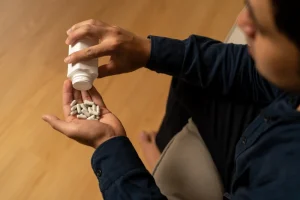
“Addiction” is the term for long-term behavioral, physical, and social changes a person may experience as a result of substance misuse. Everyone’s journey with recovery is different, but asking a healthcare professional, family member, or friend for help is usually the first step. Participating in a 12-step treatment program and getting individual counseling may reduce your chances of relapse and improve your chances for recovery. Your doctor may also prescribe other medications to help relieve symptoms of anxiety, depression, and aggression.
International Patients
There are known interaction effects of nicotine and methamphetamine and a potential role of nicotine use in maintaining their co-use [70]. The PK parameters for plasma d-amphetamine observed after oral versus intravenous administration of lisdexamfetamine (50 mg) are also summarised in Table 4. The AUC0-infinity shows that the overall drug exposure was identical https://ecosoberhouse.com/ irrespective of the route of administration. Importantly, intravenous injection of lisdexamfetamine did not either significantly increase the Cmax of d-amphetamine, nor did it significantly reduce its tmax. A comparison of the effects of the d- and l-isomers of amphetamine on noradrenaline and dopamine efflux in the brains of freely moving rats.
Amphetamines’ Effects on Your Brain

However, there are a number of medications that are FDA-approved for other illnesses that might also be useful in treating amphetamine addiction. Recent findings indicate that bupropion, the anti-depressant marketed as Wellbutrin, may reduce a methamphetamine-induced high as well as drug cravings elicited by drug-related cues. This medication and others are currently in clinical trials, while new compounds are being developed and studied in preclinical models. There is good reason to consider medications for amphetamine withdrawal that demonstrate the propensities to increase central dopamine, norepinephrine and/or serotonin activities. Four studies met the criteria to be included in this review (Srisurapanont 1999b; Jittiwutikan 1997; Kongsakon 2005; Cruickshank 2008). The results were summarized, with comparison of quantitative data where possible, between any pharmacological treatments (amineptine, mirtazapine) and placebo at the end of the 14‐day medication period.
A short history of amphetamine
Providers may also use amphetamines to treat obesity, though this is less common. Stimulants include amphetamines, meth (methamphetamine), cocaine, methylphenidate (Ritalin, Concerta, others) and amphetamine-dextroamphetamine (Adderall XR, Mydayis). They’re often used and misused in search of a “high,” or to boost energy, to improve performance at work or school, or to lose weight or control appetite. Approved by the FDA in the early 2000s, Adderall is an amphetamine and dextroamphetamine combined. Of the amphetamines, methamphetamine likely has the largest potential for abuse. Abuse of methamphetamine can cause long-lasting brain damage along with other problems.
- Your doctor may also prescribe other medications to help relieve symptoms of anxiety, depression, and aggression.
- There are no specific antidotes for amphetamine or amphetamine-like compounds.
- Always follow your healthcare provider’s instructions when taking amphetamines.

The reliance on extended periods of ‘abstinence’ as a primary endpoint does not always reflect participant treatment goals and is a somewhat insensitive marker of clinically meaningful change in substance use. However, further work is required to determine outcomes that are both clinically meaningful and meaningful to consumers. Another study enrolled 110 MA-dependent participants in the USA with active study drug for 10 weeks followed by 4 weeks of blinded placebo treatment to encourage follow-up [48]. In two earlier published studies, Jasinski and Krishnan compared the subjective effects of lisdexamfetamine and IR d-amphetamine in drug-experienced human volunteers when these compounds were administered intravenously (Jasinski and Krishnan, 2009a) and orally (Jasinski and Krishnan, 2009b). Furthermore, the time of lisdexamfetamine’s peak pharmacological effect was substantially delayed compared with IR d-amphetamine, at 3.0 h versus 1.5–2.0 h.

References to other published versions of this review
Amphetamine dependent individuals trying to discontinue or to cut down use of the drug using self‐help or even formal treatment commonly relapse, as a single use of amphetamine immediately removes discomfort and institutes a sense of well‐being or euphoria (Rawson 2002). As the initial phase of treatment requires amphetamine addiction cessation of use, amphetamine withdrawal compromises long‐term success for some individuals with severe amphetamine dependence to achieve protracted abstinence. There was no significant association between amphetamine use disorders and depression (where major depression was the outcome in all studies).
- It becomes a cycle — you seek out these experiences because they reward you with good feelings.
- Cruickshank 2008, on the other hand, used the Amphetamine Cessation Symptoms Assessment or ACSA (McGregor 2008b) to measure withdrawal symptoms.
- This is due in large part to fear of losing access to children (e.g. due to mandatory reporting), and family responsibilities (lack of alternate options for childcare, etc.); women are also more likely to encounter economic barriers to treatment access than are men [76].
- As a molecule with a single chiral centre, amphetamine exists in two optically active forms, i.e. the dextro- (or d-) and levo- (or l-) isomers or enantiomers (Figure 1).
6. Depression

Because they are the primary people dispensing medications, they can watch for falsified prescriptions or drugs that people refill too often. In 2020, about 5.1 million people in the United States reported misusing prescription stimulants, such as Adderall, within the past year. Reports indicate that children as young as eighth grade have misused prescription medications for ADHD. If you experience strong drug cravings, you may find it easier to go through amphetamine withdrawal in a hospital setting. Hospitalization may also help if you have negative mood changes, including aggression and suicidal behavior. Both prescribed and street amphetamines can be misused and cause use disorder.

The severity of withdrawal symptoms is greater in amphetamine dependent individuals who are older and who have more extensive amphetamine use disorders (McGregor 2005). Withdrawal symptoms typically present within 24 hours of the last use of amphetamine, with a withdrawal syndrome involving two general phases that can last 3 weeks or more. The first phase of this syndrome is the initial “crash” that resolves within about a week (Gossop 1982; McGregor 2005).